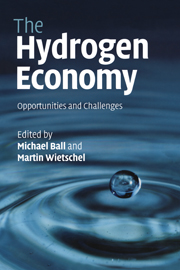Book contents
- Frontmatter
- Contents
- List of main contributors
- Preface
- Acknowledgements
- List of abbreviations
- 1 Scope of the book
- 2 Why hydrogen?
- 3 Non-renewable energy resources: fossil fuels – supply and future availability
- 4 Non-renewable energy resources: nuclear fuels
- 5 Assessment of the potentials for renewable energy sources
- 6 Carbon capture and storage
- 7 Energy-chain analysis of hydrogen and its competing alternative fuels for transport
- 8 Hydrogen today
- 9 Fundamental properties of hydrogen
- 10 Hydrogen production
- 11 Hydrogen storage
- 12 Hydrogen distribution
- 13 Key role of fuel cells
- 14 Hydrogen-infrastructure build-up in Europe
- 15 Building a hydrogen infrastructure in the USA
- 16 Hydrogen and the electricity sector
- 17 Hydrogen corridors
- 18 Macroeconomic impacts of hydrogen
- 19 Sustainable transport visions: the role of hydrogen and fuel-cell vehicle technologies
- 20 Energy-efficient solutions needed – paving the way for hydrogen
- 21 The future of hydrogen – opportunities and challenges
- Further reading
- Index
- References
19 - Sustainable transport visions: the role of hydrogen and fuel-cell vehicle technologies
Published online by Cambridge University Press: 22 January 2010
- Frontmatter
- Contents
- List of main contributors
- Preface
- Acknowledgements
- List of abbreviations
- 1 Scope of the book
- 2 Why hydrogen?
- 3 Non-renewable energy resources: fossil fuels – supply and future availability
- 4 Non-renewable energy resources: nuclear fuels
- 5 Assessment of the potentials for renewable energy sources
- 6 Carbon capture and storage
- 7 Energy-chain analysis of hydrogen and its competing alternative fuels for transport
- 8 Hydrogen today
- 9 Fundamental properties of hydrogen
- 10 Hydrogen production
- 11 Hydrogen storage
- 12 Hydrogen distribution
- 13 Key role of fuel cells
- 14 Hydrogen-infrastructure build-up in Europe
- 15 Building a hydrogen infrastructure in the USA
- 16 Hydrogen and the electricity sector
- 17 Hydrogen corridors
- 18 Macroeconomic impacts of hydrogen
- 19 Sustainable transport visions: the role of hydrogen and fuel-cell vehicle technologies
- 20 Energy-efficient solutions needed – paving the way for hydrogen
- 21 The future of hydrogen – opportunities and challenges
- Further reading
- Index
- References
Summary
This chapter examines the role of hydrogen, and fuel-cell vehicle technologies in particular, in contributing to a future sustainable transport system and also shows the limitation of such an approach. Particular areas that need to be addressed in this respect include emissions, safety, land use, noise and social inclusion. Vehicle technologies will play a key role in addressing several of these.
Introduction
Transport systems perform vital societal functions but in their present state cannot be considered ‘sustainable’. Particular concerns in this respect include climate change, local air emissions, noise, congestion and accidents. One of the most controversially discussed long-term solutions to today's problems of the transport sector is the introduction of hydrogen as an energy fuel and fuel-cell vehicles. In this chapter, we integrate the two debates – one on the transition to a ‘hydrogen economy’ and one on sustainable transport. We try to answer the question on what role hydrogen and fuel-cell vehicle technologies could play in a sustainable transport vision.
This chapter is structured as follows: Section 19.2 introduces the economic relevance of transportation by looking back at the beginning of industrialisation. Section 19.3 then summarises current evidence on the social effects of today's motor transport with reference to different world regions. Departing from this analysis, the subsequent section briefly derives a set of exit strategies towards a more sustainable transport future, considering a wide range of policy instruments and transport externalities.
- Type
- Chapter
- Information
- The Hydrogen EconomyOpportunities and Challenges, pp. 563 - 598Publisher: Cambridge University PressPrint publication year: 2009
References
- 1
- Cited by



